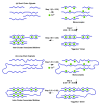A Review of Pectin-Based Material for Applications in Water Treatment
- PMID: 36984087
- PMCID: PMC10055932
- DOI: 10.3390/ma16062207
A Review of Pectin-Based Material for Applications in Water Treatment
Abstract
Climate change and water are inseparably connected. Extreme weather events cause water to become more scarce, polluted, and erratic than ever. Therefore, we urgently need to develop solutions to reduce water contamination. This review intends to demonstrate that pectin-based materials are an excellent route to detect and mitigate pollutants from water, with several benefits. Pectin is a biodegradable polymer, extractable from vegetables, and contains several hydroxyl and carboxyl groups that can easily interact with the contaminant ions. In addition, pectin-based materials can be prepared in different forms (films, hydrogels, or beads) and cross-linked with several agents to change their molecular structure. Consequently, the pectin-based adsorbents can be tuned to remove diverse pollutants. Here, we will summarize the existing water remediation technologies highlighting adsorption as the ideal method. Then, the focus will be on the chemical structure of pectin and, from a historical perspective, on its structure after applying different cross-linking methods. Finally, we will review the application of pectin as an adsorbent of water pollutants considering the pectin of low degree methoxylation.
Keywords: adsorption; cross-linking; low methoxylation degree; pectin; pollution; remediation; structural models; wastewater.
Conflict of interest statement
The authors declare no conflict of interest.
Figures







References
-
- Mihai F.-C., Gündoğdu S., Markley L.A., Olivelli A., Khan F.R., Gwinnett C., Gutberlet J., Reyna-Bensusan N., Llanquileo-Melgarejo P., Meidiana C., et al. Plastic Pollution, Waste Management Issues, and Circular Economy Opportunities in Rural Communities. Sustainability. 2022;14:20. doi: 10.3390/su14010020. - DOI
Publication types
Grants and funding
LinkOut - more resources
Full Text Sources

